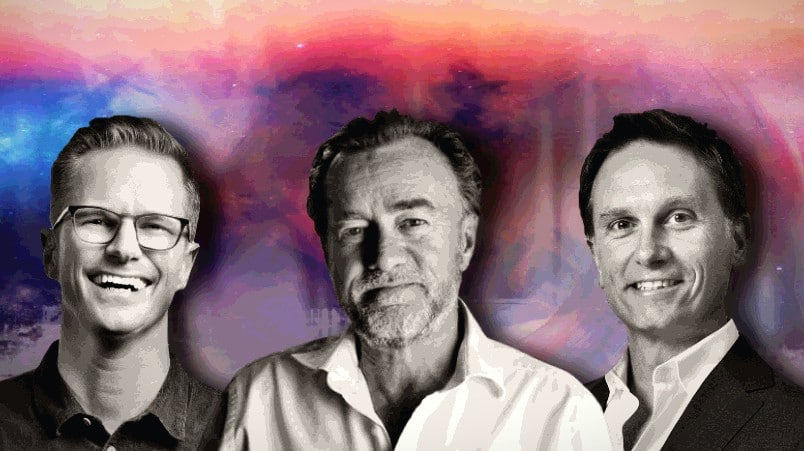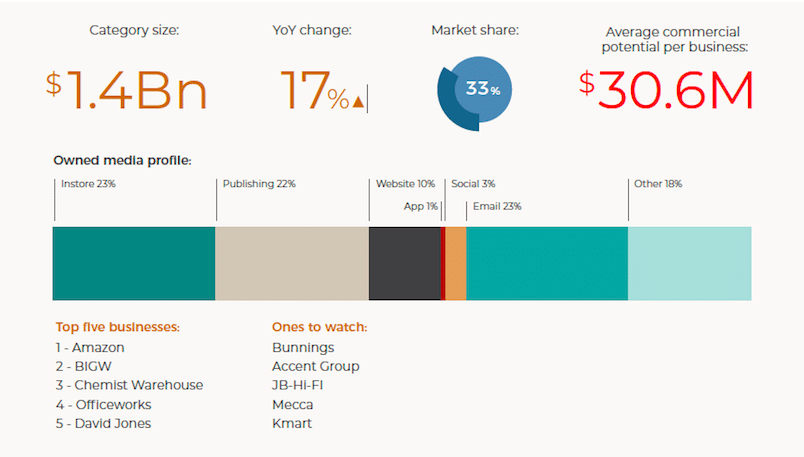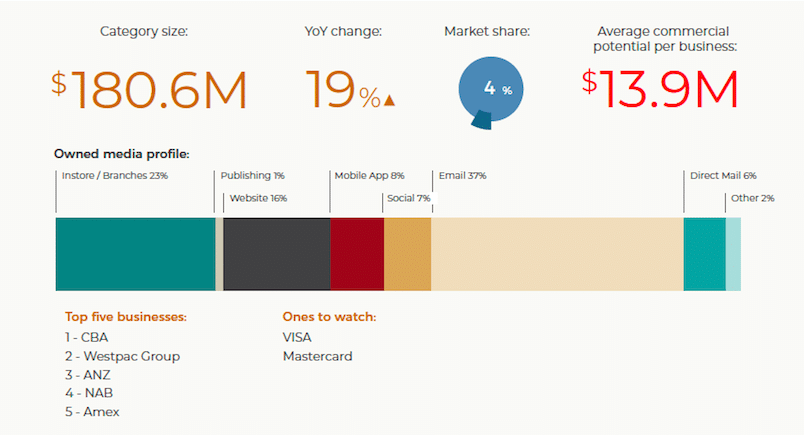
Owned media v retail media: Commbank, ANZ, Telstra invest in owned channels as sector’s commercial value increases 10% to $4.3bn; Financial services up 19% as non-retail brands eye upside
Written by By Paul McIntyre & Brendan Coyne and reproduced with the kind permission of Mi-3
Owned media in Australia – brands’ own websites, magazines, email, apps, in-store and social assets – now has $4.3bn in commercial potential. It could reach $5bn in as little as 12 months as brands, eyeing the growth of retail media, start to realise the value of their own media channels. Valuation firm Sonder has just released its annual Owned Media Market Report & Rankings for the ’24 financial year and it contextualises the retail media boom – retailers might be making all the noise but, depending on how you split the numbers, retail aggregators represent just a third of the commercial value that brands across any sector can derive from their own media channels. Mike Connaghan, MD of News Corp’s Commercial Content division, says his business is booming as the likes of Coles, Bunnings, Officeworks, David Jones and Chemist Warehouse make media revenue from suppliers and use it to fund their own paid marketing efforts as well as turn a healthy margin. Sonder is seeing the same thing. The likes of ANZ have reorganised operations to put owned channels first – and co-founder Angus Frazer thinks more will follow, especially as pressure on marketing budgets intensifies. In retail media, Sonder says the ones to watch are Bunnings, Accent Group, JB-Hi-Fi, Mecca and Kmart. In grocery and liquor it’s First Choice and Vintage Cellars, while in finance it’s Visa and Mastercard. Co-founder Jonathan Hopkins says the market is now at a “tipping point”.
Listen to the podcast here
What you need to know:
- Amazon and Big W have bigger potential commercial opportunity from owned media than Chemist Warehouse, according to Sonder’s latest owned media valuations report.
- Finance is powering, up 19 per cent as banks and credit card providers rethink the media mix in a bid to personalise and cross-sell to millions of customers via their own channels first before considering paid media. Some are restructuring processes as result.
- Across the piste, brands, banks and retailers are using owned media revenues and trading to fund paid channels as retailer media’s rise has opened eyes and minds as to the value previously being left on the table, per Sonder co-founders Angus Frazer and Jonathan Hopkins.
- News Corp Commercial Content boss Mike Connaghan backs that view. Trade is brisk, he says, both in creating commercial content and helping to sell space for brands building out media businesses.
- But brands – and marketers – tempted by sizeable financial returns available from monetising owned channels must tread carefully, warns Sonder’s Angus Frazer, or will get burnt.
- Here’s a breakdown of the potential owned media commercial value available across sectors, which firms are the biggest players – and which brands are the ones to watch – plus the channels likely to provide most upside.
- Get the full download via this week’s podcast.
Marketers are now getting that leveraging owned media channels can save them money on their paid media investments, and it can retain and attract customers that can be leveraged for indirect or direct revenue. So something that saves you money and generates you money is pretty compelling.
— Jonathan Hopkins, Founding Partner, Sonder
Retail media therapy
Retail media gets all the attention but owned media has far larger commercial potential in Australia – circa $4.3bn per latest estimates by specialist valuations consultancy Sonder. Co-founder Jonathan Hopkins suggests it could top $5bn in the next 12-36 months, but underlines it’s not all about flogging space.
At the top end of town, the likes of Commbank, ANZ, Telstra are taking different hybrid approaches, using their owned assets – emails, publishing, websites, apps, and in-store (or branch) – to first hone customer experience and engagement before extracting value from third parties keen to tap those customer bases.
Commbank is now making overt returns from its owned media, this year launching a new ad-funded magazine. Telstra has been investing in its retail store assets to commercialise marketing opportunities for handset suppliers.
ANZ meanwhile, is pushing to fully leverage owned assets first instead of putting paid media at the top of the plan. CMO Sweta Mehra sees “hundreds of millions” of dollars in value by properly leveraging its owned channels, but selling that space to others is “my smallest upside opportunity”, dwarfed by greater ability to engage, personalise and cross-sell to its existing customers.
Per Sonder’s new study, the financial services sector has seen the biggest owned media commercial potential growth over the last 12 months, up 19 per cent to $180.6m.
That said, Sonder acknowledges that retail aggregators and their media networks are the biggest single chunk of the market – while the rise of retailer media, driven particularly by the more mature grocery, liquor and chemist operators – has awoken the market to the true value of their owned assets.
“The data smarts that are demonstrated by the likes of Cartology is training supplier brands to expect more from owned media sellers,” suggests Hopkins. “So for example when L’Oreal sees the targeting and reporting they are getting from Woolworths, they’ll expect that from both pharmacies and department stores where they range their products as well.”
Either way, he suggests the broader owned media market is now at a “tipping point” as businesses and brands are under pressure to extract better value from assets and partnerships while being pushed to cut marketing investments. Owned media, per Hopkins, can help solve both of those challenges.
“Marketers are now getting that leveraging owned media channels can save them money on their paid media investments, and it can retain and attract customers that can be leveraged for indirect or direct revenue. So something that saves you money and generates you money is pretty compelling.”
I’ve seen significant sales uplift, to the point where a brand in the home DIY category that advertises through (Bunnings' owned) channels, saw a 1000% uplift in sales.
— Mike Connaghan, MD, Commercial Content, News Corp
‘Only getting bigger’
Mike Connaghan, MD at News Corp’s Commercial Content division – which generates about $150m in revenues as a hybrid outsourced publishing partner for the likes of Coles, Bunnings, Officeworks, David Jones, Chemist Warehouse and Qantas – confirms the owned media market is booming.
“The efforts we’re doing for these clients are only getting bigger,” says the former STW and GroupM AUNZ CEO. “The Coles magazine is now massive. It expands well beyond the print product, but those [supermarket] print products are the biggest magazines in the history of Australian publishing,” at north of 200 pages and with a readership of “five million and growing”, per Connaghan.
He sees no sign of a slow down across retail or broader owned media, in turn fuelling the content and sales arms of News’ main commercial content units, Medium Rare, Storyation, Suddenly and Visual Domain.
“A lot of these clients have massive customer databases with really sophisticated first party data. So not only can they market their own initiatives through those channels, but many of their partners and suppliers want to get in on the action.”
That’s because they can see the results. “You immediately see incremental sales that can be quantified through their sales data,” says Connaghan, with Coles’ magazine a prime example. “Coles can see through its scan data that people not only take that magazine home, but they shop the recipes in that magazine right down to the fine detail … So it’s a really powerful story.”
Windows of opportunity
News, via Medium Rare, is helping monetise assets for David Jones, the latest retailer to launch a media business, by bringing in brands that wouldn’t usually be ranged in its stores.
“The windows of David Jones are high street, high profile and with highly valuable customers walking past. So out-of-category opportunities for someone like David Jones through travel, through auto, are there and live,” says Connaghan.
Likewise Qantas is thinking outside the box, running “thought leadership” courses for its business customers that Connaghan says are “self-funded”.
“It’s offering Qantas’ base an amazing opportunity to be in a room with thought leaders and be deep in content that is valuable to them and their careers or their lifestyle,” says Connaghan. “There are so many different ways to think about your own channels.”
Bunnings is another example harnessing content and its own assets to drive returns.
“Bunnings used to be a completely clean in-store environment. But customers … need information, they need utility content served up to them,” says Connaghan. By taking that approach “I’ve seen significant sales uplift, to the point where a brand in the home DIY category that advertises through [Bunnings’ owned] channels, saw a 1000% uplift in sales. So it’s educational, utility, it’s putting something in somebody’s hands – how do I use this? What do I use it for? Bunnings is a classic environment to do that in … and it’s a win-win for everyone.”
If you want to succeed in this game, you need all three and you have to do it in that order: customer, partner and then your own profitable revenue. That is the triple win.
— Angus Frazer, Founding Partner, Sonder
Owned fuelling acquisition?
Sonder’s Hopkins and Frazer and News’ Connaghan disagree that putting owned media first reduces brands’ focus on acquisition or filling the customer bucket.
While owned media by nature focuses squarely on existing customers, the money brands save by properly harnessing their owned channels for their own communications can be then recycled into paid media, they underline. Plus, any revenue unlocked from owned channels can then help better fund paid media.
Meanwhile, focusing on creating better content and experiences within owned channels that works for existing customers “by default is going to attract people like them who aren’t your customer”, argues Sonder’s Hopkins. “So create that content, serve it through your own channels, judge what works and then put that through earned media and paid media to attract more customers.”
Plus, he says, banks and retailers with outward-facing digital screens within their physical stores and branches can use them for acquisition: “Why would you be investing in paid outdoor media in those locations?”
Sonder’s Angus Frazer though says the “triple win” within owned media must always start with creating content that improves customer experience and helps partner brands grow through those owned media assets before pushing to monetise those assets. “If you want to succeed in this game, you need all three and you have to do it in that order: customer, partner and then your own profitable revenue. That is the triple win.”
But Frazer cautions any brands “tempted by by some fairly significant financial returns around monetising owned media” to tread carefully and not “try to run before they can walk, or even crawl”. Put the right processes, people and structures in place before all else, he says, or risk damaging relationships.

Retail aggregators: Top five, ones to watch and commercial potential by channel. Pic: Sonder
Grocery and liquor – retail media players Woolworths and Cartology also make up the big beasts of the grocery and liquor category, which Sonder reckons has $1.2bn in commercial potential, up 12 per cent on last year’s value estimates. Dan Murphy’s, BWS and Liquorland make up the top five businesses in terms of owned media commercial potential, with First Choice and Vintage Cellars deemed ones to watch.
In terms of channels, in-store (37 per cent) and publishing (30 per cent) represent the biggest potential sources of owned media value. For the grocery and liquor players, websites represent 8 per cent of potential commercial value along with email, and apps just 3 per cent, suggests Sonder.

Finance: Top five, ones to watch and commercial potential by channel. Pic: Sonder
Finance – Sonder’s report finds finance has made the biggest gains in commercial potential from owned media, up 19 per cent to $180.6m over the last 12 months. Email (37 per cent) offers the highest commercial potential by channel, followed by in-store/branch (23 per cent), websites (16 per cent) and apps (8 per cent). While Commbank this year launched an ad-funded magazine, Sonder suggests publishing represents only 1 per cent of commercial potential within finance.
Get the full owned media story with Mike Connaghan, Angus Frazer and Jonathan Hopkins via this week’s podcast and download Sonder’s new valuation ranking report here
Engage With Sonder
We believe your fortune lies within. Look within to reframe your perspective on how to find growth.
Contact us to unlock new revenue today


